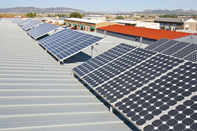Self-Storage Facilities Choose to Embrace Green Energy Practices
 While sexy new sustainable buildings and automobiles often make the eco-headlines, the self-storage facility industry has seen a steady uptick towards embracing green energy practices too (they just haven’t been as flashy about it). Many storage facilities have long used energy-saving methods like motion-sensor lights within storage units and hallways and along driveways to save money. After all, it doesn’t make sense to have lights burning constantly in areas that are only being accessed once a month or less. Beyond simple measures like motion-activated lights, the common grid layout of storage facilities makes them ideal for solar panels.
While sexy new sustainable buildings and automobiles often make the eco-headlines, the self-storage facility industry has seen a steady uptick towards embracing green energy practices too (they just haven’t been as flashy about it). Many storage facilities have long used energy-saving methods like motion-sensor lights within storage units and hallways and along driveways to save money. After all, it doesn’t make sense to have lights burning constantly in areas that are only being accessed once a month or less. Beyond simple measures like motion-activated lights, the common grid layout of storage facilities makes them ideal for solar panels.StorageMart, a large storage chain, has been experimenting with solar panels at its storage facilities in Toronto. Another storage facility in Delaware also went green in 2010. Secure Self Storage installed solar panels which provide so much energy that the facility is able to sell excess energy back to its local energy company. They’re also considering installing green roofs with vegetation which would provide insulation in winter, prolong the life of the roof, and prevents run-off water. The same facility was looking into wind power given its proximity to the coast.
Allegan U-Stor in Allegan, Michigan is another example of a green storage facility. It recently installed 104 solar panels on the sloping roofs of its storage units, giving them the distinction of having the most solar panels in Allegan County. Another mini storage facility in Hawaii chose to make an agreement to retain the natural beauty surrounding its facility. A-American Storage Management signed a voluntary conservation agreement pledging to protect 1,276 acres of land adjacent to its facility, comprising part of the Waianae Mountains in Oahu. The agreement even rules out the building of power lines.
In addition to saving money and adding to a business’ green cred, many storage facilities would benefit from the installation of solar panels, given that they already use minimal amounts of energy by running facilities that generally stand without lighting or climate control. There are even ways to green climate-controlled storage units, which are usually housed within a larger building. Seasonal climate control – where units are climate-controlled when temperatures are extreme and left uncooled or unheated during months with steady temperatures — is also gaining popularity.
You can return to the main Market News page, or press the Back button on your browser.

